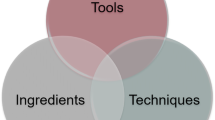Abstract
The modern field of instructional design is like others that are based on high technology—dynamic and progressively complex so there’s always a new concept, procedure or software package coming along. One of the latest concepts to become part of the field is that of learning objects. Associated fields such as software engineering have the related concept of object oriented design and programming. In their text Programming Concepts in Java, J.N. Patterson, Hume and Christine Stephenson define an object as “An object is a set of data and the methods which operate on that data” ( Patterson Hume and Stephenson 1998, p. 11).
Access provided by Autonomous University of Puebla. Download chapter PDF
Similar content being viewed by others
The modern field of instructional design is like others that are based on high technology—dynamic and progressively complex so there’s always a new concept, procedure or software package coming along. One of the latest concepts to become part of the field is that of learning objects . Associated fields such as software engineering have the related concept of object oriented design and programming. In their text Programming Concepts in Java, J.N. Patterson, Hume and Christine Stephenson define an object as “An object is a set of data and the methods which operate on that data” ( Patterson Hume and Stephenson 1998, p. 11).
One of the difficulties that can make learning objects an arcane subject is the lack of a singular definition . As far back as 1969, Ralph W. Gerard of the University of California-Irvine described the basic concept as “curricular units can be made smaller and combined, like standardized Meccano [mechanical building set] parts, into a great variety of particular programs custom-made for each learner” (Gerard 1969, pp. 29–30). This implies that the ‘curricular units’ can be reused for multiple contexts.
To bring about a standardized definition of learning objects so that there would exist a commonality of function to promote widespread usage, the Learning Technology Standards Committee (LTSC ) of the Institute of Electrical and Electronics Engineers (IEEE) was formed in 1996 to develop and promote instructional technology standards (LTSC 2000). The term ‘Learning Object’, first popularized by Wayne Hodgins in 1994 when he named the Computer Education Management Association (CedMA) working group ‘Learning Architectures, APIs and Learning Objects’ was chosen to describe these small instructional components ( Polsani 2003). A working group was established and it provided the following working definition:
Learning Objects are defined here as any entity, digital or non-digital, which can be used, re-use d or referenced during technology supported learning. Examples of technology-supported learning include computer-based training systems, interactive learning environments, intelligent computer-aided instruction systems, distance learning systems, and collaborative learning environments. Examples of Learning Objects include multimedia content, instructional content, learning objectives, instructional software and software tools, and persons, organizations, or events referenced during technology supported learning.
This definition is rather general since many things could be “referenced during technology supported learning.” Different groups outside the LTSC have created different terms that generally narrow the scope of the canonical definition down to something more specific. For example, the Wisconsin Online Resource Center (WORC) which is a partnership formed between the 16 two-year colleges of the Wisconsin Technical College System to develop high-quality, interactive, online learning resources give the following definition:
Learning objects are a new way of thinking about learning content. Traditionally, content comes in a several hour chunk. Learning objects are much smaller units of learning, typically ranging from 2 minutes to 15 minutes.
The following principles about learning objects were developed:
-
1.
They are self-contained as each learning object can be used independently.
-
2.
They are reusable in that a single learning object may be used in multiple contexts for multiple purposes.
-
3.
They can be grouped into larger collections of content, including traditional course structures.
-
4.
Every learning object has descriptive information called metadata which allows it to be easily found by a search.
Does anybody really use or care about learning objects ? Learning objects have had considerable impact on an international basis. As with any new concept, there can be some ambiguity in its usage and understanding, but it generally pertains to small, reusable units of learning ( Campbell 2003; Polsani 2003). The conventional approach is to regard learning objects as reusable chunks of content.
Via a building block approach, these learning objects may then be incorporated into higher order learning designs. Pedagogically, the purpose of contexts is to enable learners to achieve learning objectives. The design of these contexts requires choices in the selection and organization of activity and content to assist the learning process ( Boyle 2006).
References
Boyle, T. (2006). The design and development of second generation learning objects. In E. Pearson & P. Bohman (Eds.), Proceedings of World Conference on Educational Multimedia, Hypermedia and Telecommunications 2006 (pp. 2–12). Chesapeake, VA: AACE.
Campbell, L. (2003). Interoperability and reusable learning objects. PowerPoint slides from workshop on “Breaking boundaries: Innovation in medical education,” Manchester, UK, February 2003. Retrieved from http://www.medev.ac.uk/docs/breaking_boundaries/campbell_workshop.
Gerard, R. W. (1969). Shaping the mind: Computers in education. In R. C. Atkinson & H. A. Wilson (Eds.), Computer-assisted instruction: A book of readings. New York: Academic Press.
LTSC. (2000). Standards for the learning technology glossary. Working draft, IEEE P1484.3, Learning Technology Standards Committee (LTSC). Retrieved from http://ltsc.ieee.org/doc/.
Patterson Hume, J. N., & Stephenson, C. (1998). Programming concepts in Java. Toronto: Holt Software Associates.
Polsani, P. (2003). Use and abuse of reusable learning objects. Journal of Digital Information, 3(4). Retrieved August 6, 2009, from http://journals.tdl.org/jodi/article/view/89/88.
Author information
Authors and Affiliations
Rights and permissions
Copyright information
© 2016 Springer International Publishing Switzerland
About this chapter
Cite this chapter
Frantiska, J.J. (2016). Background and Significance. In: Creating Reusable Learning Objects. SpringerBriefs in Educational Communications and Technology. Springer, Cham. https://doi.org/10.1007/978-3-319-32889-8_1
Download citation
DOI: https://doi.org/10.1007/978-3-319-32889-8_1
Published:
Publisher Name: Springer, Cham
Print ISBN: 978-3-319-32888-1
Online ISBN: 978-3-319-32889-8
eBook Packages: EducationEducation (R0)




